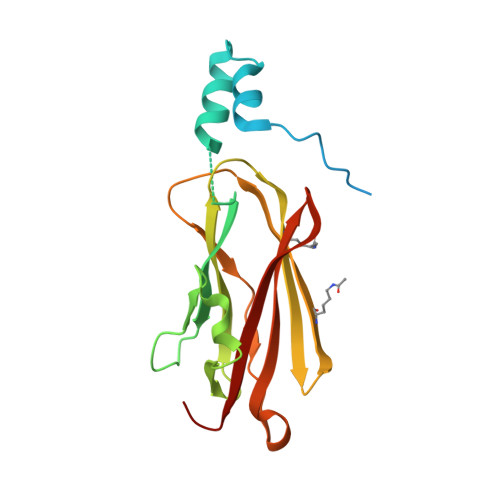Rhogdi Alpha Acetylation at K127 and K141 Affects Binding Towards Non-Prenylated Rhoa.
Kuhlmann, N., Wroblowski, S., Scislowski, L., Lammers, M.(2016) Biochemistry 55: 304
- PubMed: 26695096
- DOI: https://doi.org/10.1021/acs.biochem.5b01242
- Primary Citation of Related Structures:
5FR1 - PubMed Abstract:
Rho proteins are major regulators of the cytoskeleton. As most Ras-related proteins, they switch between an active, GTP-bound and an inactive, GDP-bound conformation. Rho proteins are targeted to the plasma membrane via a polybasic region and a prenyl group attached to a C-terminal cysteine residue. To distribute Rho proteins in the cell, the molecular chaperone RhoGDIα binds to the prenylated Rho proteins forming a cytosolic pool of mainly GDP-loaded Rho. Most studies characterized the interaction of prenylated Rho proteins and RhoGDIα. However, RhoGDIα was also shown to bind to nonprenylated Rho proteins with physiologically relevant micomolar affinities. Recently, it was discovered that RhoGDIα is targeted by post-translational lysine acetylation. For one site, K141, it was hypothesized that acetylation might lead to increased levels of formation of filamentous actin and filopodia in mammalian cells. The functional consequences of lysine acetylation for the interplay with nonprenylated RhoA have not been investigated. Here, we report that lysine acetylation at lysines K127 and K141 in the RhoGDIα immunoglobulin domain interferes with the interaction toward nonprenylated RhoA using a combined biochemical and biophysical approach. We determined the first crystal structure of a doubly acetylated protein, RhoGDIα, in complex with RhoA·GDP. We discover that the C-terminus of RhoA adopts a different conformation forming an intermolecular β-sheet with the RhoGDIα immunoglobulin domain.
Organizational Affiliation:
Institute for Genetics and Cologne Excellence Cluster on Cellular Stress Responses in Aging-Associated Diseases (CECAD), Joseph-Stelzmann-Str. 26, University of Cologne , 50931 Cologne, Germany.


















